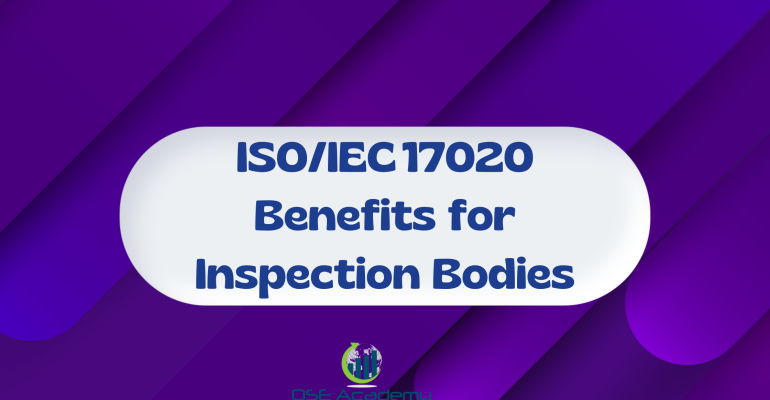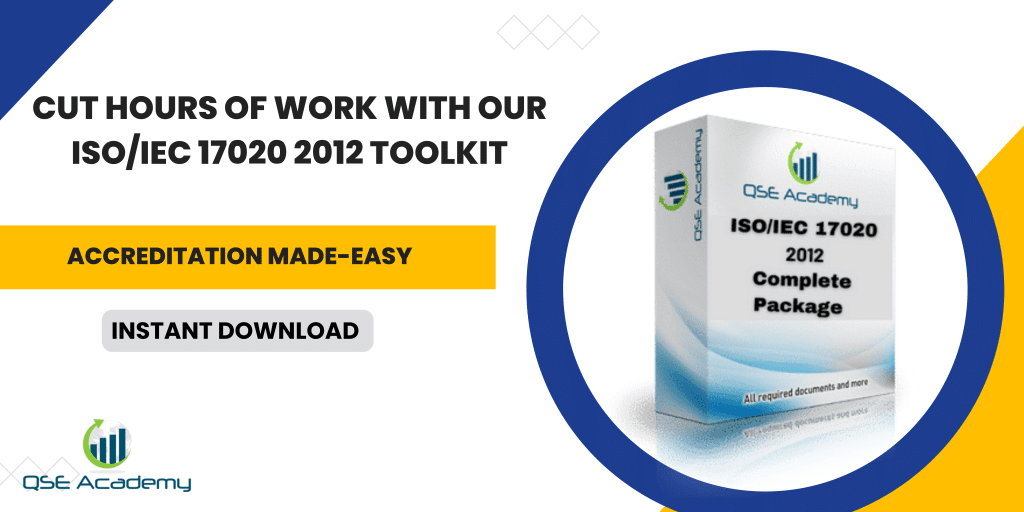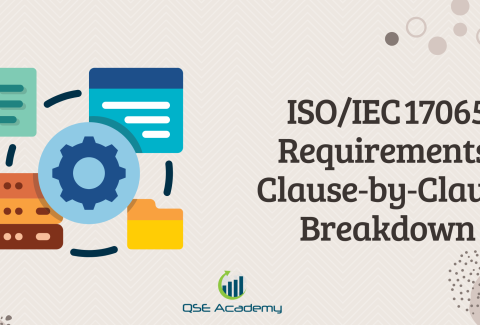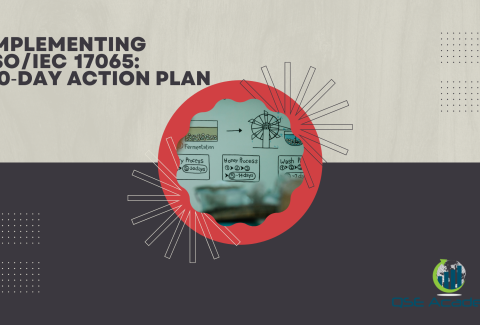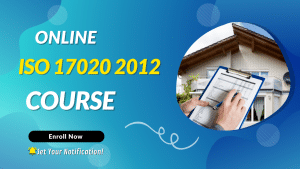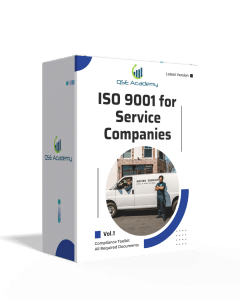ISO/IEC 17020 Benefits for Inspection Bodies
Last Updated on October 22, 2025 by Hafsa J.
Why ISO/IEC 17020 Accreditation Transforms Inspection Bodies
If you run or manage an inspection body, you’ve probably asked yourself at some point:
“Is ISO/IEC 17020 accreditation really worth it?”
In my experience working with inspection firms across construction, energy, manufacturing, and government sectors, the answer is almost always yes — but not for the reasons most people expect.
ISO/IEC 17020 isn’t just about ticking compliance boxes or impressing auditors. It’s about transforming how your organization is trusted, how it performs, and how it grows.
Here’s the simple truth: in today’s regulated industries, credibility is currency.
Clients, regulators, and certification bodies all want to know one thing — can they rely on your inspection results?
And that’s exactly what ISO/IEC 17020 accreditation delivers: verifiable confidence that your inspections are impartial, consistent, and technically competent.
Most inspection bodies notice a turning point after accreditation. Reports are accepted faster, new contract opportunities open up, and internal processes suddenly run with less friction.
That’s because accreditation forces clarity — in roles, methods, and accountability. It pushes your team to operate with the precision and impartiality expected from internationally recognized inspection bodies.
In this article, we’ll explore the real-world benefits of ISO/IEC 17020 accreditation — from regulatory recognition and market access to operational efficiency and team integrity.
By the end, you’ll see how accreditation doesn’t just prove compliance — it reshapes your organization’s reputation, stability, and long-term growth potential.
Now, let’s start with the foundation: what ISO/IEC 17020 actually is, and why it matters for every inspection body that wants to be taken seriously.
ISO/IEC 17020 in Context – The Standard That Builds Confidence
Before we explore the specific benefits, it’s important to understand what ISO/IEC 17020 is and why it matters so deeply to inspection bodies.
Many organizations confuse it with ISO 9001 or ISO/IEC 17025, but this standard plays a unique role: it certifies that your inspection decisions are independent, competent, and reliable — not just well-managed.
Purpose and Core Scope of ISO/IEC 17020
| Focus Area | Description |
|---|---|
| Main Objective | To ensure inspections are conducted impartially, consistently, and based on verified procedures. |
| Who It Applies To | Organizations performing inspections of materials, equipment, processes, installations, or services. |
| Outcome of Accreditation | Recognition that inspection results are technically sound and internationally trusted. |
| Primary Users | Third-party inspection bodies, regulatory inspection agencies, and internal (Type B/C) inspection departments. |
Unlike ISO 9001 — which focuses on overall quality management — ISO/IEC 17020 drills into how your inspection process works:
Are your inspectors qualified?
Are your reports consistent?
Are your decisions free from conflict of interest?
It’s a framework that turns ordinary inspection work into defensible, recognized assessments accepted by regulators and certification authorities worldwide.
How ISO/IEC 17020 Differs from ISO 9001 and ISO/IEC 17025
| Standard | Focus | Output | Proof of Competence |
|---|---|---|---|
| ISO 9001 | Quality management and customer satisfaction. | Internal or external certification. | Management and process consistency. |
| ISO/IEC 17025 | Testing and calibration laboratories. | Test or calibration reports. | Measurement traceability and method validation. |
| ISO/IEC 17020 | Inspection bodies and conformity assessments. | Inspection reports or certificates of conformity. | Inspector competence, impartiality, and consistent judgments. |
This distinction is crucial. ISO/IEC 17020 is not about how efficiently you manage your business — it’s about how trustworthy your inspection results are.
Why It Builds Confidence
ISO/IEC 17020 accreditation tells your clients and regulators that your organization:
-
Uses standardized and validated inspection procedures.
-
Employs qualified, authorized inspectors.
-
Operates independently from commercial or internal pressure.
-
Maintains traceability and documentation for every decision.
Together, these elements create a system of technical assurance that ordinary certifications can’t provide.
Key Insight
ISO/IEC 17020 is the difference between saying “we inspect reliably” and proving “our inspection process meets internationally accepted competence standards.”
It formalizes trust — and that’s exactly why the benefits extend far beyond compliance.
Regulatory and Legal Benefits – Recognition That Carries Authority
For most inspection bodies, the first and most visible benefit of ISO/IEC 17020 accreditation is regulatory recognition.
Regulators, certification schemes, and public authorities depend on accredited inspection bodies because accreditation gives their decisions legal weight.
It tells stakeholders that your inspection reports aren’t just accurate — they are officially trustworthy.
How Accreditation Strengthens Legal Credibility
| Regulatory Aspect | ISO/IEC 17020 Requirement | Resulting Benefit |
|---|---|---|
| Compliance with Laws and Standards | Requires inspections to be performed according to documented, recognized standards and regulations. | Ensures your organization’s reports meet statutory or industry-specific obligations. |
| Impartiality and Independence | Inspection bodies must identify and eliminate conflicts of interest. | Protects the credibility of inspection results in legal or contractual disputes. |
| Competence Verification | Inspectors must be qualified, authorized, and periodically assessed. | Provides defensible proof of technical competence during regulatory audits. |
| Record Traceability | All inspection evidence and decisions must be traceable and retained. | Enables legal defensibility and transparency in case of investigations or appeals. |
Industry Sectors Where Accreditation Is Legally Required
| Sector | Common Inspections | Why Accreditation Is Mandated |
|---|---|---|
| Construction & Infrastructure | Building safety, welding, structural integrity checks | Required by public works authorities for compliance with safety codes. |
| Energy & Utilities | Pressure vessels, pipelines, electrical systems | Mandatory for operator licensing and risk management. |
| Transportation & Automotive | Vehicle roadworthiness, emissions, safety inspections | Defined under national or regional transport laws. |
| Environmental Monitoring | Waste management, emission control, site remediation | Required to verify compliance with environmental legislation. |
| Industrial Manufacturing | Supplier verification, conformity assessment | Needed to issue conformity declarations for regulated markets. |
Impact on Regulatory Acceptance
| Before Accreditation | After ISO/IEC 17020 Accreditation |
|---|---|
| Reports may require secondary verification by authorities. | Reports are accepted directly by regulators and certification bodies. |
| Legal defensibility depends on individual reputation. | Decisions are backed by a recognized accreditation mark. |
| Higher risk of rejection in compliance audits. | Automatic recognition through ILAC MRA agreements. |
Key Insight
Accreditation shifts your organization from “service provider” to “recognized authority.”
It turns your inspection results into trusted evidence that regulators, insurers, and certification bodies can act upon without hesitation.
Business and Market Benefits – Winning Clients and Contracts
Beyond regulatory credibility, ISO/IEC 17020 accreditation delivers major business and market advantages.
It’s one of the few investments that directly increases client trust, eligibility for high-value contracts, and long-term market positioning.
In competitive industries, accreditation often becomes the deciding factor that determines who wins the job.
Why Accreditation Builds Market Confidence
| Business Area | ISO/IEC 17020 Impact | Tangible Benefit |
|---|---|---|
| Client Trust | Proves inspection results are impartial and technically verified. | Strengthens client confidence and repeat business. |
| Tender Qualification | Many bids require accredited inspection bodies only. | Expands access to public and private sector tenders. |
| Market Differentiation | Distinguishes your company from unaccredited competitors. | Enhances credibility and pricing power. |
| International Recognition | Accreditation under ILAC MRA ensures global acceptance. | Simplifies entry into foreign or regulated markets. |
Clients don’t just buy inspection services — they buy assurance.
An accredited inspection body guarantees that assurance through recognized technical competence and transparent reporting.
Accreditation as a Growth Accelerator
| Growth Factor | Before Accreditation | After ISO/IEC 17020 Accreditation |
|---|---|---|
| New Market Access | Restricted to local or low-risk clients. | Eligible for international, high-value, or government projects. |
| Client Perception | “Capable but unverified.” | “Technically proven and reliable.” |
| Partnership Opportunities | Limited to informal collaborations. | Easier partnerships with certification bodies, regulators, and global suppliers. |
| Reputation and Brand Value | Based on relationships. | Backed by independent recognition and traceable performance. |
Return on Investment (ROI) Perspective
| ROI Element | Example Outcome | Business Value |
|---|---|---|
| Contract Eligibility | Gain access to tenders that require accredited inspection reports. | Direct revenue increase. |
| Reduced Rework or Disputes | Standardized methods minimize inspection errors. | Lower operational cost and client claims. |
| Client Retention | Clients prefer accredited bodies for ongoing compliance. | Stable revenue streams. |
| Market Expansion | Recognition under ILAC MRA enables cross-border work. | Diversified client base and resilience. |
Key Insight
ISO/IEC 17020 accreditation isn’t just a quality milestone — it’s a commercial strategy.
It converts trust into opportunity, helping inspection bodies scale from local service providers to internationally recognized partners in compliance and safety.
Operational and Quality Benefits – Streamlined, Consistent Inspections
One of the most overlooked advantages of ISO/IEC 17020 accreditation is how it transforms internal operations.
Accreditation forces inspection bodies to formalize, standardize, and continually improve every process — from planning and performing inspections to issuing reports and handling nonconformities.
The result is a system that’s not only compliant but efficient, traceable, and repeatable.
How Accreditation Improves Operational Control
| Operational Area | ISO/IEC 17020 Requirement | Operational Benefit |
|---|---|---|
| Process Documentation | Every inspection activity must follow documented procedures. | Reduces variability and human error. |
| Record Control | Reports, forms, and evidence must be traceable and securely maintained. | Ensures full auditability and client confidence. |
| Internal Audits & Reviews | Regular evaluation of performance, competence, and impartiality. | Identifies weaknesses early and drives improvement. |
| Corrective Actions | Requires a defined system to handle nonconformities. | Prevents recurrence of errors and strengthens accountability. |
Standardization doesn’t just help during assessments — it improves day-to-day performance.
Inspectors work with clear guidance, management can track progress, and clients receive consistent, defensible results.
Before and After Accreditation – Operational Impact
| Area | Before Accreditation | After ISO/IEC 17020 Accreditation |
|---|---|---|
| Inspection Consistency | Procedures vary by inspector or site. | Unified methods and criteria applied organization-wide. |
| Traceability | Records often incomplete or inconsistent. | Every result traceable from raw evidence to final report. |
| Error Management | Issues corrected reactively. | Nonconformities managed systematically through corrective actions. |
| Performance Monitoring | Ad hoc reviews. | Scheduled internal audits and structured management reviews. |
Quality Improvements from Accreditation
| Quality Element | Description | Benefit to Organization |
|---|---|---|
| Defined Roles and Responsibilities | Clear assignment of who approves, verifies, and reports. | Prevents overlaps and reduces internal conflicts. |
| Competence Frameworks | Systematic qualification, training, and re-authorization of inspectors. | Increases reliability and reduces inspection errors. |
| Continuous Improvement Loop | Regular evaluation of KPIs, audits, and feedback. | Enhances quality culture and operational discipline. |
Key Insight
When implemented properly, ISO/IEC 17020 creates a self-improving management system.
You don’t just comply with requirements — you build a structure that supports consistent results, reliable data, and sustained quality over time.
Technical and Competence Benefits – Raising the Bar for Expertise
At the heart of ISO/IEC 17020 is a simple idea: inspection results are only as credible as the people who produce them.
That’s why the standard focuses heavily on technical competence, training, and authorization.
Accreditation ensures every inspector not only knows what to do — but can prove that they do it consistently, accurately, and impartially.
How ISO/IEC 17020 Strengthens Technical Competence
| Technical Requirement | What the Standard Demands | How It Benefits the Organization |
|---|---|---|
| Inspector Qualification | Inspectors must have documented education, experience, and training. | Ensures every inspection is performed by a competent professional. |
| Authorization System | Each inspector must be formally authorized for specific scopes. | Clarifies competence boundaries and reduces errors. |
| Ongoing Training and Evaluation | Continuous training and periodic reassessment are mandatory. | Keeps staff skills current and aligned with regulations. |
| Supervision and Monitoring | Senior inspectors must periodically review others’ work. | Promotes knowledge sharing and consistency in decision-making. |
These requirements create a workforce that’s technically accountable and capable of defending inspection results under scrutiny.
Competence Management – Structured and Measurable
| Competence Area | ISO/IEC 17020 Expectation | Practical Outcome |
|---|---|---|
| Knowledge | Inspectors understand relevant standards, laws, and inspection criteria. | Reduces interpretation errors and improves accuracy. |
| Skills | Inspectors can apply inspection methods and use relevant tools correctly. | Ensures consistent technical performance. |
| Judgment | Inspectors can make conformity decisions based on evidence. | Builds client confidence in impartiality. |
| Documentation | Records maintained for qualification, authorization, and reassessment. | Provides proof of competence during accreditation audits. |
Comparison: Non-Accredited vs. Accredited Inspection Body
| Area | Non-Accredited Body | ISO/IEC 17020 Accredited Body |
|---|---|---|
| Staff Qualification | Based on informal experience. | Defined qualification and training framework. |
| Method Application | May vary by inspector. | Standardized, validated methods followed consistently. |
| Impartiality Control | Not formally evaluated. | Systematic risk assessment for conflicts of interest. |
| Technical Oversight | Occasional supervision. | Documented reviews and witnessed inspections. |
Key Insight
ISO/IEC 17020 turns technical competence into a structured, auditable system.
Inspectors become accountable professionals operating under clear authorization and continual improvement.
This not only raises internal performance but also strengthens your reputation — because clients and regulators know your people are verified experts, not just experienced staff.
Strategic and Financial Benefits – Turning Compliance into Growth
While most inspection bodies pursue ISO/IEC 17020 accreditation for compliance or regulatory reasons, the strategic and financial gains often exceed those expectations.
Accreditation can fundamentally change how your business grows, how it’s perceived in the market, and how efficiently it operates over time.
When managed well, ISO/IEC 17020 becomes more than a quality benchmark — it’s a strategic investment that delivers measurable returns.
How Accreditation Strengthens Strategic Positioning
| Strategic Area | ISO/IEC 17020 Contribution | Strategic Impact |
|---|---|---|
| Reputation & Trust | Independent recognition of technical competence and impartiality. | Builds stronger brand authority and client loyalty. |
| Risk Management | Systematic procedures reduce liability and inspection errors. | Protects against legal, financial, and reputational risk. |
| Business Continuity | Standardized operations ensure consistency even as staff or clients change. | Improves resilience and scalability. |
| Decision-Making | Data from audits, KPIs, and reviews guide leadership decisions. | Enables informed strategy and continuous improvement. |
ISO/IEC 17020 accreditation helps leadership move from reactive management to strategic control, using facts and performance data instead of assumptions.
Financial Advantages of Accreditation
| Financial Aspect | Before Accreditation | After ISO/IEC 17020 Accreditation |
|---|---|---|
| Contract Eligibility | Limited to smaller or low-regulation clients. | Access to government and international contracts requiring accredited bodies. |
| Operational Costs | Higher due to rework, inefficiency, or disputes. | Reduced errors, improved traceability, and fewer client complaints. |
| Revenue Growth | Dependent on relationships. | Driven by documented competence and recognized credibility. |
| Profit Stability | Prone to fluctuation. | Strengthened by long-term accredited client agreements. |
By enhancing efficiency, credibility, and client confidence, accreditation often pays for itself within the first few contract cycles.
Strategic ROI Breakdown
| Category | Benefit | Example Result |
|---|---|---|
| Compliance ROI | Fewer audit nonconformities and penalties. | Reduced cost of corrective actions. |
| Operational ROI | Process standardization improves turnaround times. | 15–25% faster inspection cycle on average. |
| Commercial ROI | Access to new regulated tenders and markets. | Increase in contract volume and client retention. |
| Brand ROI | Enhanced market reputation and recognition. | Stronger pricing power and competitive edge. |
Key Insight
ISO/IEC 17020 accreditation is a long-term profitability enabler.
It reduces inefficiencies, increases access to profitable markets, and positions your organization as a trusted compliance partner rather than just a service provider.
Internal Culture and Leadership Benefits – Building a Culture of Integrity
The most powerful — and often underestimated — impact of ISO/IEC 17020 accreditation is cultural.
It changes how leaders manage, how inspectors think, and how teams collaborate.
Once accreditation becomes part of your organization’s DNA, integrity, accountability, and professionalism stop being policies on paper — they become daily habits.
How ISO/IEC 17020 Shapes Organizational Culture
| Cultural Element | ISO/IEC 17020 Influence | Organizational Impact |
|---|---|---|
| Impartiality | Requires formal identification and control of conflicts of interest. | Promotes ethical decision-making and client trust. |
| Accountability | Each inspector is authorized and responsible for specific scopes. | Builds ownership and pride in technical work. |
| Transparency | Every inspection result must be documented, reviewed, and traceable. | Reduces internal silos and improves communication. |
| Continuous Improvement | Periodic reviews, audits, and corrective actions are mandatory. | Fosters a culture of learning and performance enhancement. |
Accreditation makes quality everyone’s responsibility.
Instead of management enforcing compliance, teams internalize it — because they understand how their work contributes to the organization’s credibility.
Leadership Development Through Accreditation
| Leadership Area | ISO/IEC 17020 Effect | Result |
|---|---|---|
| Decision-Making | Leaders rely on objective data from audits, reviews, and KPIs. | More consistent and evidence-based leadership. |
| Team Empowerment | Clear structure of roles and competencies. | Managers delegate with confidence; teams perform with clarity. |
| Strategic Vision | Accreditation goals align technical quality with business strategy. | Promotes long-term thinking and operational maturity. |
| Ethical Leadership | Impartiality and independence become leadership norms. | Strengthens trust internally and externally. |
ISO/IEC 17020 doesn’t just build better processes — it builds better leaders.
Those leaders, in turn, sustain the culture that accreditation depends on.
Workforce Morale and Engagement
| Employee Factor | Change Brought by Accreditation | Benefit |
|---|---|---|
| Clarity of Roles | Defined responsibilities and reporting lines. | Reduces confusion and boosts productivity. |
| Recognition | Authorized inspectors gain formal acknowledgment of competence. | Increases motivation and professional pride. |
| Feedback Mechanisms | Regular audits and reviews create transparent feedback loops. | Strengthens learning culture and teamwork. |
| Sense of Purpose | Inspectors see their work contributing to public safety and trust. | Builds commitment and ethical engagement. |
Key Insight
ISO/IEC 17020 creates a culture of technical integrity that outlasts individual projects or personnel.
It aligns leadership, values, and daily behavior around one shared goal: to deliver inspections that are impartial, reliable, and respected everywhere.
FAQs – Common Questions About ISO/IEC 17020 Benefits
Even after understanding the value of ISO/IEC 17020 accreditation, inspection bodies often have practical questions about how benefits apply to their size, scope, and goals.
Below are the most frequently asked questions — and clear, experience-based answers.
FAQ 1: Does ISO 9001 give the same benefits as ISO/IEC 17020?
| Comparison Area | ISO 9001 | ISO/IEC 17020 |
|---|---|---|
| Purpose | General quality management standard ensuring customer satisfaction and continual improvement. | Technical competence and impartiality framework specifically for inspection bodies. |
| Output | Certificate of quality system conformity. | Accreditation confirming inspection competence and reliability. |
| Recognition | Recognized by customers and partners. | Recognized by regulators, certification schemes, and international accreditation networks. |
Answer:
ISO 9001 improves management consistency, but ISO/IEC 17020 adds technical authority.
Think of ISO 9001 as proof you can manage quality — and ISO/IEC 17020 as proof you can deliver technically valid inspection results.
FAQ 2: How quickly do the benefits appear after accreditation?
| Timeline | Typical Impact |
|---|---|
| Short Term (0–6 months) | Enhanced client confidence, improved internal organization, fewer errors. |
| Mid Term (6–12 months) | Eligibility for new tenders, improved team performance, smoother audits. |
| Long Term (1–3 years) | Stronger market reputation, reduced operational risk, sustained profitability. |
Answer:
Most inspection bodies notice immediate internal improvements within months, and commercial or contractual gains within the first year.
FAQ 3: Is ISO/IEC 17020 worth it for small or specialized inspection bodies?
| Organization Type | Applicability | Core Benefit |
|---|---|---|
| Small firms (1–10 staff) | Yes – scalable implementation possible. | Builds early credibility and supports tender participation. |
| Medium firms (10–50 staff) | Highly recommended. | Strengthens structure and market presence. |
| Specialized niche providers | Essential for international recognition. | Enables cooperation with larger clients and certification schemes. |
Answer:
ISO/IEC 17020 is fully scalable. Small inspection firms benefit from structure, recognition, and access — often leveling the playing field with larger competitors.
FAQ 4: Does accreditation improve international recognition?
| Factor | Effect of ISO/IEC 17020 |
|---|---|
| ILAC MRA Recognition | Your reports are accepted by regulators and certification bodies in other countries. |
| Global Client Confidence | Multinational companies recognize ISO/IEC 17020 as a trusted benchmark. |
| Trade Facilitation | Reduces the need for repeated inspections when products cross borders. |
Answer:
Yes. Accreditation under a signatory of the ILAC Mutual Recognition Arrangement (MRA) ensures your inspection results carry the same credibility abroad as they do at home.
FAQ 5: What’s the most underestimated benefit of ISO/IEC 17020?
| Category | Overlooked Benefit | Why It Matters |
|---|---|---|
| Cultural | Builds integrity and professional discipline among staff. | Sustains long-term trust. |
| Strategic | Strengthens decision-making with reliable data and reviews. | Aligns quality with business strategy. |
| Financial | Reduces hidden costs of nonconformities, complaints, and rework. | Increases overall profitability. |
Answer:
The hidden advantage of accreditation is organizational maturity — it professionalizes every level of the inspection body, from technicians to top management.
Turning Compliance into Competitive Advantage
ISO/IEC 17020 accreditation is far more than a regulatory checkbox — it’s a catalyst for growth, trust, and technical excellence.
It transforms inspection bodies from simply doing the work to being recognized authorities whose results are accepted by regulators, clients, and international partners without question.
Whether your organization is small or large, public or private, the core benefit remains the same:
accreditation builds credibility you can’t buy — only earn.
Key Takeaways
| Benefit Category | What You Gain | Why It Matters |
|---|---|---|
| Regulatory & Legal Recognition | Your inspection reports are trusted and accepted by authorities. | Removes barriers to licensing and compliance. |
| Business & Market Growth | Access to tenders, clients, and global partnerships. | Expands revenue opportunities and brand reach. |
| Operational Excellence | Streamlined processes, fewer errors, improved consistency. | Boosts efficiency and quality performance. |
| Technical Competence | Verified inspector qualifications and impartiality systems. | Strengthens trust and reduces risk. |
| Cultural & Leadership Growth | Teams work with integrity and purpose. | Sustains long-term success and reputation. |
Why It Matters Strategically
Accreditation doesn’t just validate your inspections — it enhances how you lead, how your teams perform, and how your organization is perceived.
It embeds discipline, impartiality, and transparency at every level, giving your company a competitive advantage that lasts well beyond the next audit cycle.
Next Steps to Realize These Benefits
| Step | Action | Result |
|---|---|---|
| 1 | Conduct a readiness gap analysis against ISO/IEC 17020. | Identifies what’s missing and what’s strong. |
| 2 | Define your inspection body type (A, B, or C) and scope. | Clarifies your independence model and coverage. |
| 3 | Implement or refine your management system and competence program. | Builds technical and operational credibility. |
| 4 | Contact your national accreditation body. | Begin the formal accreditation process with confidence. |
Final Insight
In my experience, the organizations that gain the most from ISO/IEC 17020 are those that treat it not as an obligation — but as a strategic transformation.
It turns inspection work into a trusted profession, clients into long-term partners, and compliance into measurable business value.
Next Step:
If you’re ready to identify your potential gains, download QSE Academy’s “ISO/IEC 17020 Benefits & ROI Worksheet.”
It walks you through how accreditation can strengthen your compliance position, streamline operations, and grow your inspection business sustainably — from the inside out.
I hold a Master’s degree in Quality Management, and I’ve built my career specializing in the ISO/IEC 17000 series standards, including ISO/IEC 17025, ISO 15189, ISO/IEC 17020, and ISO/IEC 17065. My background includes hands-on experience in accreditation preparation, documentation development, and internal auditing for laboratories and certification bodies. I’ve worked closely with teams in testing, calibration, inspection, and medical laboratories, helping them achieve and maintain compliance with international accreditation requirements. I’ve also received professional training in internal audits for ISO/IEC 17025 and ISO 15189, with practical involvement in managing nonconformities, improving quality systems, and aligning operations with standard requirements. At QSE Academy, I contribute technical content that turns complex accreditation standards into practical, step-by-step guidance for labs and assessors around the world. I’m passionate about supporting quality-driven organizations and making the path to accreditation clear, structured, and achievable.

